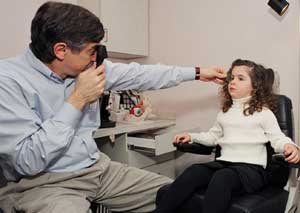Every eye doctor knows that catching amblyopia early provides the best chance for treating it effectively. But, eye doctors are split over the most appropriate method.
In one corner, organized ophthalmology and pediatricians advocate vision screenings. They say screenings are not only cost-effective but identify most kids with the condition. Mandatory vision exams, they say, put a strain on the already thinly-stretched health-care dollar.
In the other corner, optometrists and spectacle industry groups say that screenings are not effective enough. They say comprehensive vision exams for children would detect more cases of vision problems, and that over the course of an amblyopes life, the cost of comprehensive exams is very cost-effective.
But, this last claim had no research to support it. Until now.
A new study, prepared by Abt Associates and underwritten by Vision Council of America, finds that comprehensive eye exams for children would outperform mandatory vision screenings and successfully treat 144% more children who have amblyopia.1
 |
| Compared with vision screenings, comprehensive eye exams would successfully treat 144% more children who have amblyopia, according to a new study from VCA. |
Furthermore, the study found that replacing vision screenings with comprehensive exams would also be highly cost-effective and would demonstrate a greater return on investment than many comparable health care interventions.
The study measured cost-effectiveness through a value of quality-adjusted life years (QALY), a unit that stands for the additional costs required to generate one year of perfect health. Health care interventions that cost less than $50,000 per QALY are considered cost-effective, the study says. Those that cost less than $20,000 are considered extremely cost-effective. To replace a system of mandatory vision screenings with comprehensive exams would come in at a highly effective $18,390 per QALY, the study found.
Comprehensive exams cost considerably more than vision screenings, the study says. But our results suggest that the higher costs associated with them are more than offset by the gains that result from the additional children who are successfully treated as a result of having a comprehensive exam.
On the heels of the study, the American Academy of Ophthalmology (AAO) issued a news release doubting the studys methodology, thereby doubting its conclusions.
Vision screening serves more children for less cost and is highly effective in picking up vision loss in younger children, the AAO maintains. Mandating complete eye exams for all preschool children is medically unnecessary and wasteful of limited resources.
The medical community should embrace eye exams, not oppose them, counters ophthalmologist Susan J. Taub, a professor at Northwestern University who supports this latest study. This study proves that eye exams are not only better at saving sight, but one of the most cost-effective interventions available.
In other amblyopia research, two recent studies also examined quality-of-life issues and found that:
Patching is hard, but wont hurt. A recent study on the emotional effect of amblyopia treatment of preschool children looked at the difficulty parents had in treating their child with patching or with glasses.2 About half had trouble treating their child with glasses, and 3 out of 4 parents had difficulty in patching their child.
However, neither form of treatment had a negative impact on the childs well being or behavior either during or after the treatment period. Most children were described as being happy, cooperative and good tempered and having no problems at school or nursery at all ages, with no differences between treatment groups, the study authors write. By 5.5 years, a small but significant proportion was occasionally experiencing teasing at school, and all these were children who still wore glasses.
Amblyopia has no effect on job prospects. New data from the Blue Mountains Eye Study concludes that amblyopia doesnt diminish a persons employment prospects.3 The study looked at 118 subjects age 49 and older, and re-examined 73 of them five years later. Although amblyopia had no effect on employment levels for this population, fewer amblyopes completed college degrees compared with people without the condition.
1. White AJ. Eye Exams for Children: Their Impact and Cost Effectiveness. Vision Council of America, Sept 2004.
2. Hrisos S, Clarke MP, Wright CM. The emotional impact of amblyopia treatment in preschool children: randomized controlled trial. Ophthalmology 2004 Aug;111(8):1550-6.
3. Chua B, Mitchell P. Consequences of amblyopia on education, occupation, and long term vision loss. Br J Ophthalmol 2004 Sep;88(9):1119-21.

